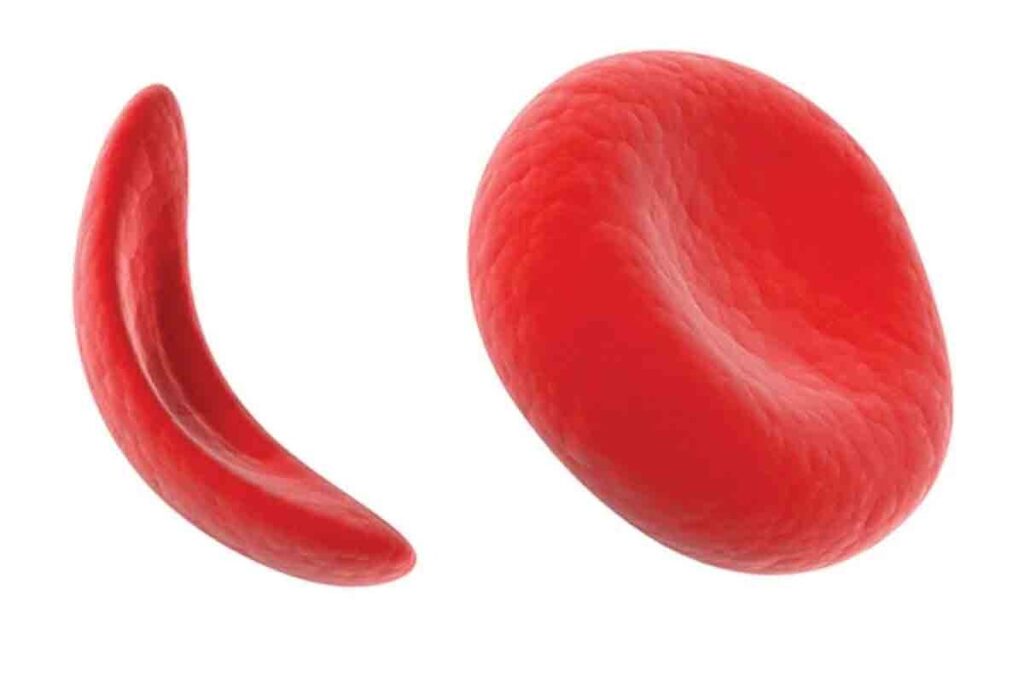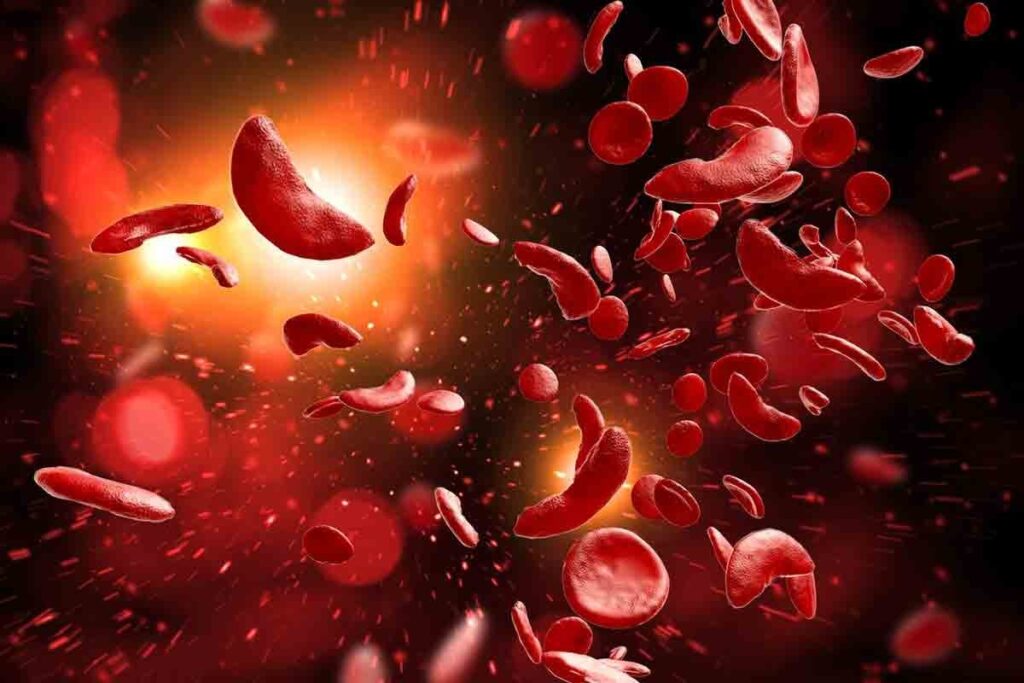
Sickle cell disease is a severe condition found in Africa, the Middle East, and parts of India. Aplastic crisis is a serious problem that can happen. It stops the bone marrow from making red blood cells, causing severe anemia.
A sudden drop in red blood cell production is very scary. It can turn a manageable condition into a serious emergency. At Liv Hospital, we offer trusted, respected care for sickle cell crises. We make sure patients get the best and most caring treatment.

Sickle cell disease is a complex genetic disorder that affects hemoglobin production. It leads to various health complications. The disease is caused by abnormal hemoglobin, known as sickle hemoglobin or hemoglobin S.
This abnormal hemoglobin causes red blood cells to take on a sickle shape. This shape makes it hard for the cells to move through small blood vessels. This leads to vaso-occlusion and other complications.
We will explore the pathophysiology of sickle cell disease. We will also look at common complications and how they affect the patient’s quality of life.
The pathophysiology of sickle cell disease starts with a genetic mutation. This mutation leads to the production of hemoglobin S. Hemoglobin S causes red blood cells to sickle, mainly when oxygen levels are low.
The sickling of red blood cells leads to their premature destruction (hemolysis). It also causes the occlusion of small blood vessels. This results in tissue ischemia and pain crises.
Patients with sickle cell disease face various complications. These include vaso-occlusive crises, aplastic crises, and sequestration crises. Vaso-occlusive crises happen when sickled red blood cells block blood vessels. This causes tissue ischemia and pain.
Aplastic crises occur when infections like parvovirus B19 temporarily stop red blood cell production. This worsens anemia.
| Crisis Type | Description | Triggers |
| Vaso-occlusive Crisis | Obstruction of blood vessels by sickled red blood cells, leading to tissue ischemia and pain. | Low oxygen tension, dehydration, and infection |
| Aplastic Crisis | Temporary halt in red blood cell production, often due to infection, worsening anemia. | Parvovirus B19 infection |
| Sequestration Crisis | Pooling of red blood cells in the spleen, leading to severe anemia. | Infection, other stressors |
Sickle cell disease has a big impact on patients’ quality of life. It causes chronic pain, frequent hospitalizations, and psychological distress. The unpredictability of crises and the need for ongoing medical care can affect patients’ social and vocational functioning.
Understanding the complexities of sickle cell disease is key. Healthcare providers can offer better management strategies and support. This can improve patient outcomes.

Understanding aplastic crisis in sickle cell anemia is key to managing it well. An aplastic crisis happens when the bone marrow stops making red blood cells. This often starts with a parvovirus B19 infection.
An aplastic crisis means the bone marrow suddenly stops making red blood cells. This is usually because of a parvovirus B19 infection. The virus attacks the cells that make red blood cells, stopping production.
The main points about aplastic crisis are:
It’s important to know the difference between aplastic crisis and baseline anemia in sickle cell disease. Baseline anemia is chronic and comes from hemolysis. An aplastic crisis is an acute event where red blood cell production fails.
The main differences are:
Aplastic crises are a big problem for patients with sickle cell disease, mostly in children. The spread of parvovirus B19, the main cause, is changing worldwide. This affects how often aplastic crises happen in sickle cell anemia.
Important facts include:
Knowing the signs of aplastic crisis is key to better care. We’ll cover the main symptoms to watch for. This helps both doctors and patients act fast.
The first signs of aplastic crisis include acute fatigue and pallor. These happen when red blood cell production drops. A rapid heartbeat may also occur as the body tries to make up for less oxygen.
These symptoms might start small but can get worse fast. It’s important for patients to keep an eye on their health. They should see a doctor right away if they notice these signs.
As aplastic crisis gets worse, symptoms get more serious. Shortness of breath is common because the blood can’t carry enough oxygen. Patients might also feel dizzy or lightheaded.
These symptoms need quick medical check-ups. This helps avoid serious problems like heart failure.
In serious cases, aplastic crisis can be very dangerous. Look out for severe shortness of breath, chest pain, and heart failure signs. Quick medical help is vital to handle these issues well.
| Symptom | Description | Severity |
| Acute Fatigue | Sudden onset of tiredness due to reduced red blood cell production | Mild to Moderate |
| Pallor | Paleness of the skin due to anemia | Mild to Moderate |
| Rapid Heartbeat | Increased heart rate to compensate for reduced oxygen delivery | Moderate |
| Shortness of Breath | Difficulty breathing due to decreased oxygen-carrying capacity | Moderate to Severe |
It’s important to know what causes aplastic crisis in sickle cell disease patients. Aplastic crisis is a serious problem where red blood cell production suddenly drops. This usually happens because of infections or other factors.
Parvovirus B19 is the main cause of aplastic crisis in sickle cell disease patients. This virus attacks the bone marrow, stopping it from making red blood cells. People with sickle cell anemia are hit hard because their red blood cells don’t last long.
Key facts about parvovirus B19 infection:
Parvovirus B19 isn’t the only virus that can cause aplastic crisis. Other viruses like:
These viruses can also harm the bone marrow’s ability to make blood cells. But how they do it can differ.
There are other things that can trigger aplastic crisis in sickle cell disease patients. These include:
Knowing about these triggers is key to preventing and managing aplastic crisis.
It’s important to know the difference between aplastic crisis and vaso-occlusive sickle cell crisis. Both are serious but need different treatments.
Vaso-occlusive sickle cell crisis causes sudden, severe pain. This happens when sickled red blood cells block blood vessels. An aplastic crisis, on the other hand, is when red blood cell production drops a lot. This often happens because of a parvovirus B19 infection, leading to severe anemia.
Vaso-occlusive crisis pain is sudden and severe, often in the limbs, back, or chest. But hemoglobin levels don’t drop much at first. Aplastic crisis, though, shows symptoms of severe anemia like fatigue, shortness of breath, and being very pale.
Lab tests help tell these crises apart. In a vasospastic-occlusive crisis, hemoglobin levels might not change much or drop a little. But in aplastic crisis, the reticulocyte count drops a lot because the bone marrow fails to make new red blood cells.
For vaso-occlusive crisis, labs show high white blood cell counts and signs of inflammation. Aplastic crisis is marked by a low reticulocyte count. This shows the bone marrow can’t make new red blood cells.
Treatment for vaso-occlusive crisis focuses on pain relief. This includes using pain medicines, staying hydrated, and sometimes needing an exchange transfusion. Aplastic crisis management involves supportive care. This often includes red blood cell transfusions to help with severe anemia until the bone marrow gets better.
Healthcare providers need to understand these differences. They must give the right care at the right time. Vaso-occlusive crises need quick pain relief and possibly transfusions. Aplastic crises need monitoring and support until the bone marrow starts working again.
Diagnosing aplastic crisis requires a mix of clinical checks and lab tests. If a sickle cell anemia patient shows signs of an aplastic crisis, we start a diagnostic process. This process confirms the condition and rules out other possible causes.
Laboratory tests are key in diagnosing an aplastic crisis. The first step is a complete blood count (CBC) with a peripheral smear. This test shows how severe the anemia is and what the bone marrow is doing.
The reticulocyte count is a vital part of the CBC. It measures young red blood cells in the blood. In an aplastic crisis, this count is usually low, showing the bone marrow isn’t making enough new red blood cells.
| Laboratory Test | Expected Finding in Aplastic Crisis |
| Complete Blood Count (CBC) | Severe anemia |
| Reticulocyte Count | Low |
| Peripheral Smear | Absence of reticulocytes, presence of sickled red cells |
Imaging studies are sometimes used to help diagnose or rule out other problems. For example, a chest X-ray might be done to look for infections or lung issues that could be affecting the patient.
When diagnosing an aplastic crisis, it’s important to think about other conditions that might look similar. This includes other sickle cell disease crises, like vaso-occlusive or splenic sequestration crises. A detailed clinical evaluation and lab tests help tell these conditions apart.
We also need to consider other reasons for anemia and bone marrow problems, like infections or certain medicines, or toxins. A full medical history and the right tests are key to making an accurate diagnosis.
Aplastic crisis in sickle cell anemia needs quick and detailed care to avoid serious problems. The care plan includes many steps to keep the patient stable, find the cause, and prevent more issues.
When a patient might have a plastic crisis, a full check-up is key. This includes looking at their medical history and doing a physical exam. Finding out what caused it, like parvovirus B19, is very important.
Tests like blood counts and reticulocyte counts help confirm the crisis and see how bad it is. Keeping an eye on vital signs and making sure the patient drinks enough water is also important. Sometimes, they need to stay in the hospital for better care.
Blood transfusions are a big part of treating aplastic crises. They help get more oxygen to the body’s tissues and lower the chance of serious problems. Deciding to give blood transfusions depends on how bad the anemia is and how the patient is doing.
It’s important to manage blood transfusions well to avoid too much iron or the body making antibodies against blood. Checking hemoglobin levels often and adjusting transfusions as needed helps the patient do better.
Supportive care is also very important for managing aplastic crisis. This includes giving emotional support to the patient and their family, managing pain, and stopping infections with vaccines and medicine.
Supportive care also means watching for serious problems like heart failure or acute chest syndrome. By using blood transfusions and supportive care together, we can help patients with aplastic crisis get better.
Patients with sickle cell anemia need careful long-term management after an aplastic crisis. This care focuses on recovery, monitoring, and adjusting their treatment plan. It helps prevent future complications.
The time it takes to recover from an aplastic crisis varies. Usually, red blood cell counts return to normal in 1-2 weeks. But this can change based on the crisis’s severity and treatment success. It’s important to watch closely and follow up to catch any new problems early.
Regular checks are key to spotting complications early. Blood tests are used to track red blood cell count and hemoglobin levels. Patients should know the signs of complications, like severe anemia or jaundice, to get help fast.
After an aplastic crisis, the treatment plan might need to be changed. This could mean adjusting medications or transfusions. It’s a chance to review and strengthen preventive steps, like vaccinations and infection prevention, to lower the risk of future crises.
The American Society of Hematology says, “A detailed care plan with preventive steps and timely actions can greatly improve sickle cell disease outcomes.”
To prevent aplastic crises in sickle cell anemia, we need a few key steps. These include stopping infections, getting vaccinated, and keeping a close eye on health. By taking these steps, we can lower the chance of aplastic crises. This helps improve life for those with sickle cell disease.
Stopping infections is key to managing sickle cell disease. Parvovirus B19 infection can cause aplastic crises. So, it’s important to prevent it. Here’s how:
These steps help lower the chance of getting parvovirus B19.
Vaccines are vital in stopping infections that might lead to aplastic crises. It’s important for patients with sickle cell disease to get all their vaccines. This includes:
| Vaccination | Importance | Frequency |
| Influenza | Prevents flu, which can trigger a crisis | Annual |
| Pneumococcal | Protects against pneumococcal disease | As recommended by guidelines |
| Meningococcal | Guards against meningococcal disease | As recommended by guidelines |
Keeping a close eye on patients with sickle cell disease is vital. This means:
By using these strategies, we can greatly reduce the risk of aplastic crises. This improves outcomes for those with sickle cell anemia.
Managing sickle cell disease needs a full plan to stop and handle crises. New treatments have made life better and longer for those with the disease. We talked about how to spot and avoid aplastic crisis, a serious problem.
Good crisis management means knowing when a plastic crisis happens, why it happens, and how to stop it. This helps lower the chance of serious problems and makes treatment work better. It’s about keeping infections away, getting the right shots, and checking on patients often.
We stress the need for a complete plan to handle sickle cell disease. This includes quick action for aplastic crisis and ongoing care. With these steps, we can make life better for those with sickle cell disease and lower the risk of crises.
An aplastic crisis is a serious problem in sickle cell anemia. It happens when the bone marrow suddenly stops making red blood cells. This often happens because of a virus called parvovirus B19.
Early signs include feeling very tired and looking pale. As it gets worse, you might have trouble breathing. If it gets very bad, you need to see a doctor right away because of severe anemia and heart problems.
Doctors use a few tests to figure out if you have an aplastic crisis. They check your blood and look at how many new red blood cells you’re making. This helps them make sure it’s not something else.
An aplastic crisis is when your bone marrow stops making red blood cells. A vaso-occlusive crisis is when sickled red blood cells block blood vessels, causing pain and other issues.
First, doctors check you out and make sure you’re okay. Then, they might give you blood transfusions. They also watch you closely to handle any problems that come up.
Yes, you can lower your risk. Stay away from infections, get vaccinated, and keep an eye on your health. This can help avoid getting sick with viruses that can cause an aplastic crisis.
Parvovirus B19 is the main cause of aplastic crisis in sickle cell disease. It stops your bone marrow from making new red blood cells, leading to a big drop in your red blood cell count.
Sickle cell disease can really affect your life. It can cause crises that need constant care and can lead to serious health problems over time.
Long-term care means watching for problems, adjusting your treatment plan, and seeing your doctor regularly. This helps prevent future crises and keeps your condition under control.
How long it takes to get better depends on how bad the crisis was and how well the treatment worked. Usually, people can start feeling better in a few weeks with the right care.
Have questions or need assistance? Our team is here to help you with appointments, services, or general inquiries.